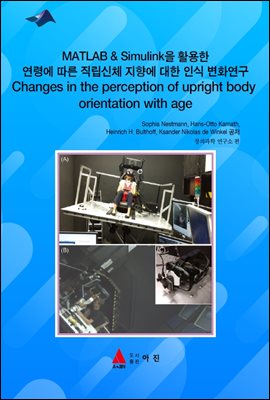
MATLAB & Simulink을 활용한 연령에 따른 직립신체 지향에 대한 인식 변화연구(Changes in the perception of upright body orientat
- 저자Sophia Nestmann, Hans-Otto Karnath, Heinrich H. B?lthoff, Ksander Nikolas de Winkel 저
- 출판사아진
- 출판일2020-07-14
- 등록일2020-12-21
- SNS공유


- 파일포맷PDF
- 파일크기8MB
- 공급사YES24
-
지원기기
PC
PHONE
TABLET
프로그램 수동설치
전자책 프로그램 수동설치 안내
아이폰, 아이패드, 안드로이드폰, 태블릿,
보유 1, 대출 0,
예약 0, 누적대출 7, 누적예약 0
책소개
To determine own upright body orientation the brain creates a sense of verticalityby a combination of multisensory inputs. To test whether this process is affected
by aging, we placed younger and older adults on a motion platform and
systematically tilted the orientation of their visual surroundings by using an
augmented reality setup. In a series of trials, participants adjusted the orientation
of the platform until they perceived themselves to be upright. Tilting the visual
scene around the roll axis induced a bias in subjective postural vertical
determination in the direction of scene tilt in both groups. In the group of older
participants, however, the observed peak bias was larger and occurred at larger
visual tilt angles. This indicates that the susceptibility to visually induced biases
increases with age, possibly caused by a reduced reliability of sensory information.
목차
제 1편 : SIMULINK 기본편1.1 SIMULINK의 시작 1
블록의 연결 5
블록 파라미터의 설정 7
시뮬레이션 파라미터 (Configuration Parameters)의 설정 8
시뮬레이션의 수행 9
블록 파라미터의 표시 9
복수 데이터의 표시 11
2.2 동적 시뮬레이션 13
이차 미분방정식 17
선형 상태변수 모델 23
DC 모터의 시뮬레이션 24
함수 블록의 사용 29
차분방정식(difference equation)의 모델링 34
Subsystem(부시스템)의 구성 37
제 2편 : 연구논문
Changes in the perception of upright body orientation
with age
1. Introduction 41
2. Methods 42
3. Task & stimuli 44
4. Participants 45
5. Discussion 48
6. Supporting information 50
7. References 51

















